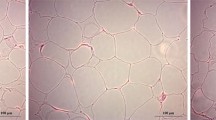Abstract
Background
Previous studies have shown a reduction of elevated androgen levels in premenopausal women after marked weight loss induced by bariatric surgery. In this study, we aimed to assess whether circulating androgen levels also decline after bariatric surgery in women displaying normal values preoperatively as well as in postmenopausal women.
Methods
In 36 severely obese women (six postmenopausal), levels of total testosterone, dehydroepiandresterone sulfate (DHEA-S), and sex hormone-binding globulin (SHBG) were assessed before and at ~1 year after gastric bypass. Free and bioavailable testosterone levels as well as the free androgen index were calculated by established formulas.
Results
After the surgery, women had lost on average 43.1 ± 1.8 kg. Independently of the pre/postmenopausal state, women showed a marked reduction in all testosterone-related androgen markers and DHEA-S levels, while SHBG levels markedly increased (all P < 0.001). Respective changes were found in both women with and without preoperatively elevated levels. Changes after the surgery in testosterone-related markers as well as in SHBG levels but not in DHEA-S levels were correlated with changes in insulin levels independently of body weight changes.
Conclusions
Data show a marked reduction of androgen levels in severely obese women after a surgically induced weight loss, which is independent from the menopausal state and preoperative levels. The mechanisms and consequences of these hormonal changes induced by bariatric surgery should be addressed in further studies.

Similar content being viewed by others
References
Norman RJ, Dewailly D, Legro RS, et al. Polycystic ovary syndrome. Lancet. 2007;370:685–97.
Samojlik E, Kirschner MA, Silber D, et al. Elevated production and metabolic clearance rates of androgens in morbidly obese women. J Clin Endocrinol Metab. 1984;59:949–54.
Rotterdam ESHRE/ASRM-Sponsored PCOS Consensus Workshop Group. Revised 2003 consensus on diagnostic criteria and long-term health risks related to polycystic ovary syndrome (PCOS). Hum Reprod. 2004;19:41–7.
Gambineri A, Pelusi C, Vicennati V, et al. Obesity and the polycystic ovary syndrome. Int J Obes Relat Metab Disord. 2002;26:883–96.
Wild RA. Obesity, lipids, cardiovascular risk, and androgen excess. Am J Med. 1995;98:27S–32S.
Goodman-Gruen D, Barrett-Connor E. Sex hormone-binding globulin and glucose tolerance in postmenopausal women. The Rancho Bernardo Study. Diabetes Care. 1997;20:645–9.
Haffner SM, Katz MS, Stern MP, et al. The relationship of sex hormones to hyperinsulinemia and hyperglycemia. Metabolism. 1988;37:683–8.
Pasquali R, Casimirri F, Plate L, et al. Characterization of obese women with reduced sex hormone-binding globulin concentrations. Horm Metab Res. 1990;22:303–6.
Preziosi P, Barrett-Connor E, Papoz L, et al. Interrelation between plasma sex hormone-binding globulin and plasma insulin in healthy adult women: the telecom study. J Clin Endocrinol Metab. 1993;76:283–7.
Soler JT, Folsom AR, Kaye SA, et al. Associations of abdominal adiposity, fasting insulin, sex hormone binding globulin, and estrone with lipids and lipoproteins in post-menopausal women. Atherosclerosis. 1989;79:21–7.
Tchernof A, Toth MJ, Poehlman ET. Sex hormone-binding globulin levels in middle-aged premenopausal women. Associations with visceral obesity and metabolic profile. Diabetes Care. 1999;22:1875–81.
Brolin RE. Bariatric surgery and long-term control of morbid obesity. JAMA. 2002;288:2793–6.
Buchwald H, Avidor Y, Braunwald E, et al. Bariatric surgery: a systematic review and meta-analysis. JAMA. 2004;292:1724–37.
Buchwald H. Bariatric surgery for morbid obesity: health implications for patients, health professionals, and third-party payers. J Am Coll Surg. 2005;200:593–604.
Fisher BL, Schauer P. Medical and surgical options in the treatment of severe obesity. Am J Surg. 2002;184:9S–16S.
Maggard MA, Shugarman LR, Suttorp M, et al. Meta-analysis: surgical treatment of obesity. Ann Intern Med. 2005;142:547–59.
Escobar-Morreale HF, Botella-Carretero JI, Alvarez-Blasco F, et al. The polycystic ovary syndrome associated with morbid obesity may resolve after weight loss induced by bariatric surgery. J Clin Endocrinol Metab. 2005;90:6364–9.
Kopp HP, Krzyzanowska K, Schernthaner GH, et al. Relationship of androgens to insulin resistance and chronic inflammation in morbidly obese premenopausal women: studies before and after vertical banded gastroplasty. Obes Surg. 2006;16:1214–20.
Dixon JB, O'Brien PE. Neck circumference a good predictor of raised insulin and free androgen index in obese premenopausal women: changes with weight loss. Clin Endocrinol. 2002;57:769–78.
Barba M, Schunemann HJ, Sperati F, et al. The effects of metformin on endogenous androgens and SHBG in women: a systematic review and meta-analysis. Clin Endocrinol (Oxf). 2009;70:661–70.
Vermeulen A, Verdonck L, Kaufman JM. A critical evaluation of simple methods for the estimation of free testosterone in serum. J Clin Endocrinol Metab. 1999;84:3666–72.
Carter GD, Holland SM, Alaghband-Zadeh J, et al. Investigation of hirsutism: testosterone is not enough. Ann Clin Biochem. 1983;20:262–3.
Matthews DR, Hosker JP, Rudenski AS, et al. Homeostasis model assessment: insulin resistance and beta-cell function from fasting plasma glucose and insulin concentrations in man. Diabetologia. 1985;28:412–9.
Kupelian V, Page ST, Araujo AB, et al. Low sex hormone-binding globulin, total testosterone, and symptomatic androgen deficiency are associated with development of the metabolic syndrome in nonobese men. J Clin Endocrinol Metab. 2006;91:843–50.
Ding EL, Song Y, Manson JE, et al. Sex hormone-binding globulin and risk of type 2 diabetes in women and men. N Engl J Med. 2009;361:1152–63.
Pasquali R, Vicennati V, Gambineri A, et al. Sex-dependent role of glucocorticoids and androgens in the pathophysiology of human obesity. Int J Obes (Lond). 2008;32:1764–79.
Davis SR, Shah SM, McKenzie DP, et al. Dehydroepiandrosterone sulfate levels are associated with more favorable cognitive function in women. J Clin Endocrinol Metab. 2008;93:801–8.
Stewart PM. Aging and fountain-of-youth hormones. N Engl J Med. 2006;355:1724–6.
Voznesensky M, Walsh S, Dauser D, et al. The association between dehydroepiandosterone and frailty in older men and women. Age Ageing. 2009;38:401–6.
Conflict of interest
No conflicts of interest were declared by any of the authors: BE, BW, MT, and BS.
Author information
Authors and Affiliations
Corresponding author
Rights and permissions
About this article
Cite this article
Ernst, B., Wilms, B., Thurnheer, M. et al. Reduced Circulating Androgen Levels After Gastric Bypass Surgery in Severely Obese Women. OBES SURG 23, 602–607 (2013). https://doi.org/10.1007/s11695-012-0823-9
Published:
Issue Date:
DOI: https://doi.org/10.1007/s11695-012-0823-9




